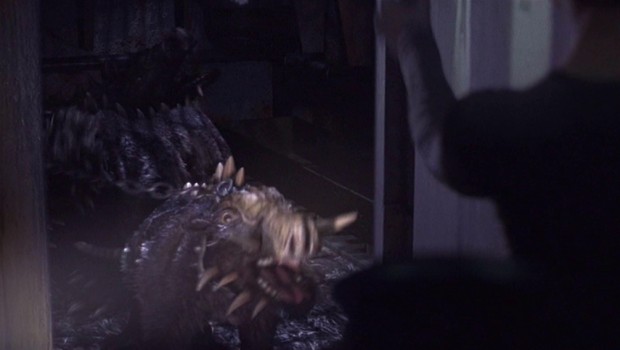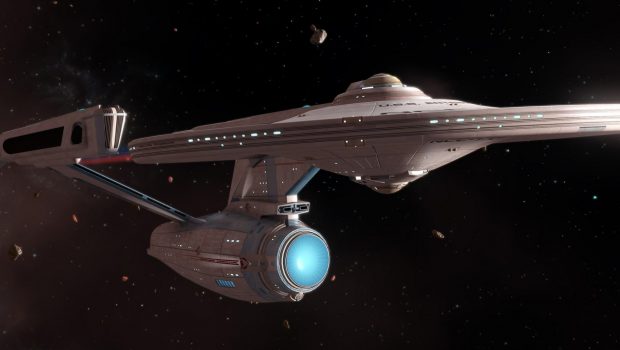
Romanus Spatium Satanum: The Subspace Devilfish
Named for the region of space in which it was discovered and its devil-like appearance, Romanus spatium satanum is a species of solanogen-based life form native to the mysterious realms of subspace. While evidence indicates many Federation and Romulan vessels have encountered the creature in the past, the Starfleet exploratory vessel USS Gorkon (NCC-82293) made the first recorded encounter recently with an unusual specimen of Romanus spatium satanum. The Gorkon barely escaped from the devilfish’s clutches when the creature attempted to drain power from the starship’s EPS reserves.
Due to the hasty departure of the Gorkon from the Roman Expanse, they recovered little sensor data on the creature. However, when they combined collected data with a repository of advanced alien knowledge given to the crew of the Gorkon by the Seraphim, an intelligent subspace species, a much more comprehensive picture formed.
According to the Seraphim, Romanus spatium satanum is based upon the subspace element solanogen in the same way most biological life found in our universe is based upon the element carbon. This is a trend researchers have found in the few biological subspace lifeforms discovered.
The creature itself is massive, over 2.2 kilometers at its widest dimension. The devilfish looks similar in appearance to the Terran aquatic starfish, but biologically, scientists classify the creature closer to crustaceans like the Risan barnacle. However, no direct comparison will be adequate for a species developed in a completely separate space-time from our own.
The specimen encountered by the Gorkon had five distinct “arms,” again like a starfish, each arm measuring an average of 700 meters and the longest measuring at over 1,100 meters. Scientists theorize other individuals of the species could have fewer or many more arms.
Ensign Seneca Wilde is an exobiologist and astrophysicist serving as the lead scientist on the team studying the Seraphim repository at the time. She believes the creature the Gorkon encountered seems to be an aberrant specimen.
“From what we can tell — from cellular deformities in certain epidermal lymph nodes — these things are normally much smaller, say, about a meter arm-to-arm,” she said.
This begs the question: why is this specimen so large?
From the information provided by the Seraphim, the pulsar cluster at the center of the Expanse created a specific tetryonic/photon resonance in the surrounding space/subspace, which allowed the devilfish to travel between space-time fissures.
“It could cross from subspace into our space practically at will,” said Wilde. “Now these devilfish, as far as we know, get energy from a process similar to photosynthesis, only with tetryons: tetrysynthesis, if you will. This devilfish found a way into our space-time — which is full of photonic light instead of tetryonic light — and started converting photons into its tetrysynthesis process.”
Photons, while travelling much slower than tetryons, have much more energy per particle than tetryons. Once the devilfish began using photons this way, it couldn’t stop.
“It started growing larger because of all the fresh energy, but its larger size now required even more energy, which made it even larger,” explained Wilde. “It was a vicious circle, and it’s why the devilfish needed to keep feeding off the electroplasmatic energy from starships. Once it got to a large enough size, photonic light wasn’t good enough for it so it needed more concentrated energy, and it got that from the ships that got trapped in the nebula because of the subspace fissures.”
The devilfish encountered by the Gorkon also had the terrifying ability to radiate high-energy, electroplasmatic shockwaves from emitter cells in its epidermal layers. Wilde said these shockwaves are normally mild in others of Romanus spatium satanum, but this specimen — because of its extreme size and use of high-energy photons in its tetrysynthesis process — could radiate shockwaves registering an energy output higher than several dozen high-yield photon torpedoes.
This defensive feature has military defense contractors very interested.
According to anonymous sources on Cardassia Prime, a joint scientific team from the Arcturai-Gand Military Defense Corporation of Cardassia and the Kang Teth’a Corporation of the Klingon Empire has plans to send heavily reinforced starships into the nebula to do further research upon the subspace creature.
- Romanus Spatium Satanum: The Subspace Devilfish - 239711.27
- One year later, Inox remains in chaos - 239303.16
- Narala names Ventu as Federation Secretary of the Exterior - 239302.22
- Trill Festival of Life kicks off with dancing, food, and costumes - 239301.14
- Narala wins 2392 presidential election - 239212.22
- Narala leads post-debate polls as election draws near - 239212.11
- VOTE NOW: FNS Debate Transcript and Poll - 239212.05
- President Bacco announces deal to end Transport Union strike - 239208.15
- Scandal before Presidential State of the Federation address? - 239206.07
- Revolutionaries capture fourth largest Inoxan city - 239205.09


 Previous Article
Previous Article Next Article
Next Article Fire on Haldon IV Engulfs Forest
Fire on Haldon IV Engulfs Forest  Cardassia Prime faces potential medical crisis as genetic mutation affects Cardassian hybrids
Cardassia Prime faces potential medical crisis as genetic mutation affects Cardassian hybrids  Launch of the USS Juneau
Launch of the USS Juneau  Berlin Zoo welcomes first targ pups
Berlin Zoo welcomes first targ pups  Discovered remnants of a possible pre-warp culture on Eta Corvi V
Discovered remnants of a possible pre-warp culture on Eta Corvi V  USS Moniy Finds Ancient Alien Runes On Mars
USS Moniy Finds Ancient Alien Runes On Mars  Constitution-class Vessel USS Ahwahnee Discovered Near Klingon Federation Border
Constitution-class Vessel USS Ahwahnee Discovered Near Klingon Federation Border  Risa begins overhaul of weather control system
Risa begins overhaul of weather control system